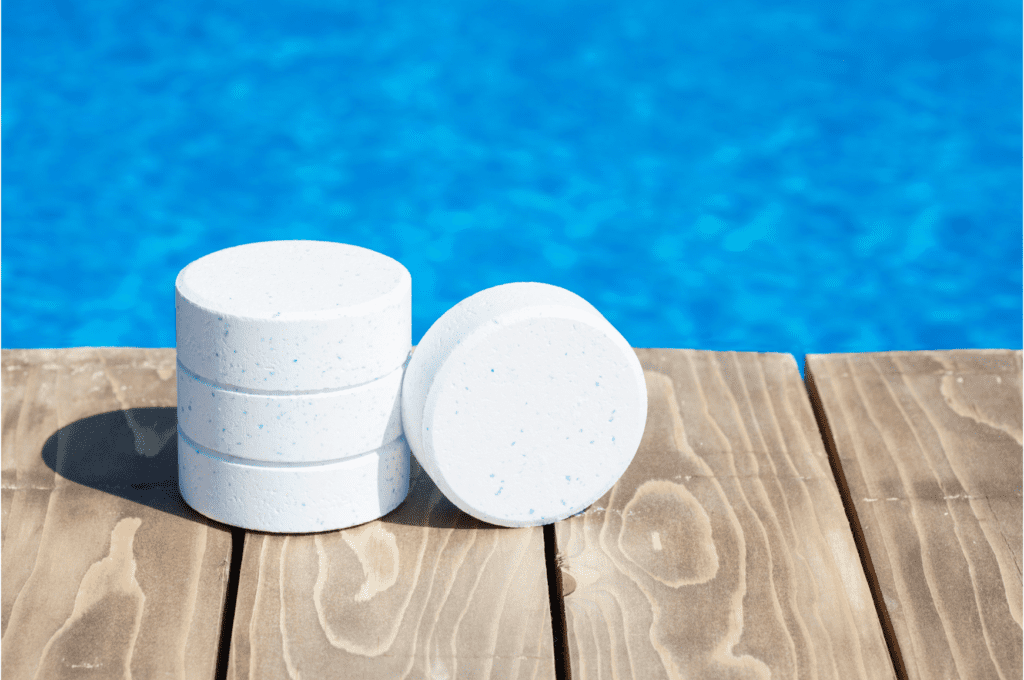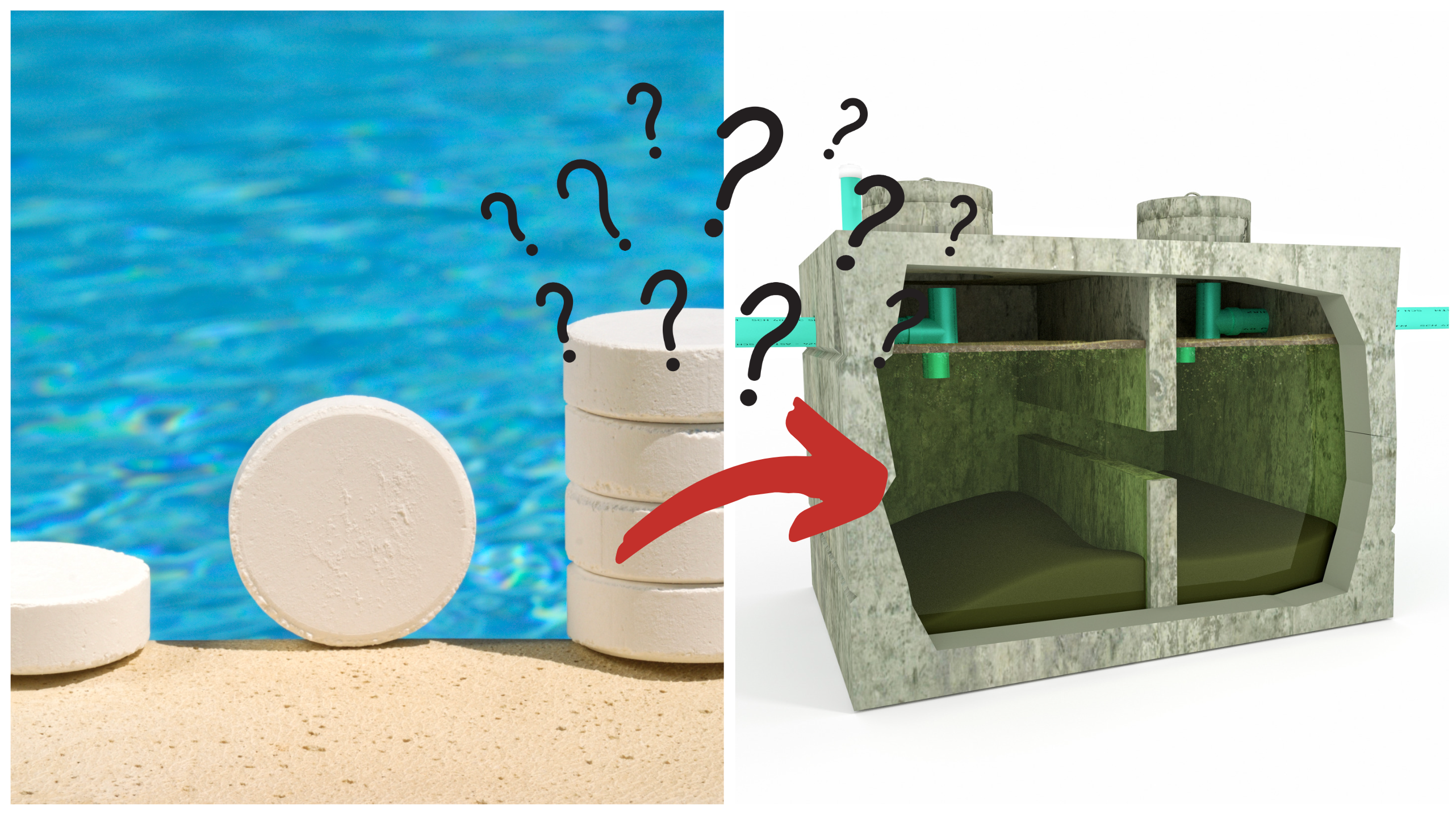Ever looked at a chlorine tablet and wondered, “Can this go in my septic tank?” Well, you’re not alone.
Many of us might think of chlorine as a cleaning powerhouse, but when it comes to your septic system, the situation gets a bit complicated.
So, let’s dive in and explore whether chlorine tablets and your septic tank could be friends or foes. Get ready, because there’s more to this story than meets the eye. Buckle up and let’s get started!
Chlorine’s Big Role in Water Treatment
A Quick Dip Into the History of Chlorine in Water Treatment
Guess what? Chlorine has been cleaning up our water for over a hundred years. Thanks to a smart British doc, John Snow, we learned way back in 1854 that cholera comes from dirty water.
That was a big “ah-ha” moment. We realized water could make us sick, so we needed to make it safe to drink.
Flash forward to the mid-1890s, and chlorine is starting to make a splash in Maidstone, a town in the UK.
The first time it’s used continuously?
That happened in Jersey City, New Jersey, in 1908. Chlorine was a hit and soon, it was making water safer all around the globe.
Why? Because it’s effective, it doesn’t break the bank, and it’s easy to use.
Chlorine’s Magic Touch
Let me tell you, chlorine is one tough cookie against those bad guys, the microorganisms in water. It attacks their cell walls, leaving them harmless.
Imagine it like this: chlorine sends the microbial cell into a spin, leading to its self-destruction.
This neat trick doesn’t just kill harmful bacteria, viruses, and protozoa, it stops them from growing and multiplying too.
Plus, chlorine has a cool superpower – it sticks around in the water for quite a while after treatment.
That means it continues to protect us as the water travels from the treatment plant to our homes.
Chlorine vs. Other Water Treatment Heavyweights
Even though chlorine is a pretty popular disinfectant, it’s not the only one in the ring. Let’s look at the other contenders: ozone, ultraviolet (UV) light, and chloramine.
Ozone? Super strong, kills microorganisms in a jiffy. But it’s got a weak spot – it leaves no backup disinfectant in the water. Plus, it can be a bit pricier than chlorine.
Then there’s UV light. It does a number on the microorganisms’ DNA so they can’t reproduce. But like ozone, it doesn’t provide a backup disinfectant and needs clear water to do its thing.
UV systems can also be a bit touchy with changes in water quality and temperature, and they can be costlier to run than chlorine setups.
Lastly, there’s chloramine, a tag team of chlorine and ammonia. It’s less likely to react with organic stuff than chlorine, which means fewer by-products.
But it’s not as strong a disinfectant as chlorine, and you’ve got to be careful managing water pH and temperature with it.
All of these methods have their pros and cons. The best one for you? That depends on a bunch of stuff like your water source, your setup, your budget, and local rules.
But despite all these choices, chlorine still holds its own because it’s effective, sticks around to keep water safe, and it’s cost-effective.
What’s Chlorine Got to Do With Septic Systems?

The Upsides of Using Chlorine
Squashing Harmful Bacteria
Chlorine is pretty good at playing the hero, taking out harmful pathogens in water treatment processes. Guess what? It does the same in your septic system.
This is especially cool when there’s a risk of your septic tank overflowing or leaking. We definitely don’t want those nasty bacteria contaminating our groundwater or nearby water sources, right?
Could Boost Water Quality
Here’s a theory: by wiping out harmful bacteria, chlorine might jazz up the quality of the water leaving your septic system.
Less bacteria means less risk of dirtying up the environment.
The Downsides of Using Chlorine
Wiping Out Helpful Bacteria
But wait, not all bacteria are bad guys. Your septic system needs a bunch of friendly bacteria to break down waste.
Add chlorine to the mix, and you might end up waving goodbye to these helpful little guys too.
Might Damage Your Septic System
Chlorine can be harsh stuff. If you use too much, it might eat away at parts of your septic system like plastic or rubber bits.
Thinking About Mother Nature
Chlorine might kill harmful bacteria, but it’s no saint. In large amounts, it can react with organic matter and create nasty by-products like trihalomethanes and haloacetic acids.
These things aren’t kind to the environment and can be harmful to us in high doses.
Plus, if chlorine-treated water from your septic system ends up in local rivers or lakes, it could harm the critters living there.
What the Experts Say About Chlorine in Septic Systems
Sure, some folks think using chlorine in septic systems is a good idea, but a lot of experts aren’t fans.
The big worry is about the friendly bacteria in the system. Research shows chlorine can really mess up this bacterial balance, impacting the system’s ability to handle waste.
Experts also warn that adding chlorine might cause more trouble than it’s worth. It could not only kill off helpful bacteria, but also damage your system and harm the environment.
So, before you even think about adding chlorine or any other chemical to your septic system, chat with a septic system pro or your local health department.
They’ll guide you based on your specific situation and local rules.
Let’s Talk Chlorine Alternatives for Your Septic System
Got Bacteria? Consider Bacterial Additives
Think about swapping out chlorine and other tough chemicals for bacterial additives.
These products pack a punch with bacteria and enzymes that work overtime to break down waste in your septic tank.
But, like most things, folks are divided on them. Some folks are all in, while others feel they’re overkill if your septic system is doing its job.
So, it’s best to chat with a septic system pro before jumping in.
Pump and Inspect Regularly
Pumping and inspections are like a spa day for your septic system.
Pumping gets rid of solid waste that builds up over time, and inspections catch any sneaky issues before they blow up.
How often you do this depends on a few things like your tank size, how many people are in your house, and how much wastewater you’re making.
A good rule to live by is to get an inspection every 1-3 years and a pump every 3-5 years.
Clean Green With Environmentally Friendly Cleaners
What you wash down your drains matters to your septic system. Some cleaners, especially those with bleach or other strong chemicals, can throw off your tank’s bacteria balance.
Try out environmentally friendly cleaners instead. They’re usually biodegradable and free of harmful chemicals, making them a friend to your septic system and Mother Nature.
Natural Ways to Keep Your Septic System Happy
If bacterial additives and eco-friendly cleaners aren’t your thing, there are other natural ways to care for your septic system.
Conserve Water
Less water use means less strain on your septic system. Little things like fixing leaks, using water-efficient appliances, and spacing out your laundry loads can make a big difference.
Be Careful What You Flush
Remember, not everything should go down your drains. Avoid flushing stuff like diapers, wipes, coffee grounds, fats, oils, and grease.
These can block your system and mess with the bacteria in your tank.
Smart Landscaping
What you plant around your septic system can help too. Avoid deep-rooted trees or shrubs that could damage your septic tank.
Go for grass or small plants instead for erosion protection without risking your system’s health.
By doing these, you’ll keep your septic system in tip-top shape without using possibly harmful chemicals like chlorine.
Conclusion
We’ve journeyed through the world of chlorine, septic systems, and their intricate relationship.
Now we know that chlorine tablets might not be the best party guests for our septic system friends.
But don’t fret, there are plenty of other ways to keep your system healthy and happy. Remember, each septic system is unique and so are its needs.
So, when in doubt, reach out to a pro for advice. Thanks for sticking around, and until next time, keep those septic systems thriving!
Video Version of the Blog Post
We have created a video version for this blog post. If you like this video, consider subscribing to the House Notebook Youtube Channel.
Let’s Clear Up Some Common Questions (FAQs)
Can I Use Chlorine Tablets in My Septic System?
Chlorine is a champ at disinfecting water, but it’s not great for septic systems.
It can wipe out the good bacteria your septic system needs to work right, no matter what type of system you have.
Before adding anything to your septic system, it’s best to talk with a septic system pro or your local health department.
What Happens When I Use Chlorine in My Septic Tank?
When you add chlorine to your septic tank, it goes to work right away killing bacteria. But remember, it’s taking out the good guys along with the bad.
Over time, losing those good bacteria can mess with how well your system works, or even cause it to fail.
Plus, if you use too much chlorine, it could damage parts of your septic system.
Are There Rules About Using Chlorine in Septic Systems?
The rules about using chlorine or other additives in your septic system can be different depending on where you live.
Some places might limit their use or need you to get a permit because of the possible effects on the environment.
It’s always smart to check with your local health department or regulation agency to know what rules you need to follow.
Can I Use Swimming Pool Chlorine Tablets in My Septic System?
Pool chlorine tablets are made to clean pool water, not septic systems.
They might have more chlorine than your septic system can handle. Using these tablets could hurt your system by killing the good bacteria and damaging parts of the system.
Plus, some types of pool chlorine tablets can be dangerous, even explosive, if they get wet or are handled wrong.
Always check with a professional before adding any chemicals to your septic system.
